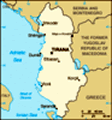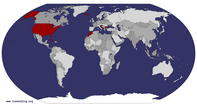Advertisement
Though our nearly two-week tour of the Balkans already had a full-to-the-brim schedule of activities and sights from Albania to Slovenia, our time in Albania itself was relatively short and the better part of that was spent in
Tirana. However, when booking our tour we were offered several varied optional excursions for an additional charge. One of these was an afternoon/evening excursion to the small but interesting and historic town of
Krujë which was only a short drive of 45 minutes or so from Tirana. Weighing our options, we decided to book the Krujë tour and some others in advance of our trip. The excursion took place on our second day in Albania, and as it turned out, not only did we have a beautiful day for the visit, but it was my favorite experience in Albania, and well worth the extra money to see Krujë.
Fushë-Krujë Once out of Tirana, the drive to Krujë took us through the small town of
Fushë-Krujë, another site where Skanderbeg battled the Ottomans in the mid-15th century, as well as the place where
Shote Galica, an Albanian National Heroine, died in 1927 in the struggles against Serbia. The city is lately more
well known for being visited by an American President, George W. Bush; the 10-year anniversary of his visit takes place on June 10, 2017. In 2007, President Bush met with then Albanian Prime Minister Sali Berisha and voiced his support for the independence of Kosovo in which the largest ethnic group was Albanian.
At the time, President Bush was the first American president to have visited Albania. We saw the statue of President Bush that
Fushë-Krujë erected as well as the town square where it was located, and was named in his honor.
Krujë While the approach to scenic Krujë is mostly on flat land, you cannot miss seeing the mountains of the South Dinaric Alps rising in the background and the changing landscape which is definitely more lush. Krujë hugs the mountain side below Mount Krujë, near the Ishëm River, which gives it a fabulous panoramic view of the valley below.
Due to its position on the mountainside and its narrow and ascending cobblestone lanes, most vehicular traffic here is kept to a minimum which makes it all so much more atmospheric.Since so many of our group had also opted in for this excursion, we
had to be transported by our regular tour bus to the edge of Krujë, then take minibuses to get closer to town as larges buses are not allowed.
We finished the last leg on foot which was beneficial in terms of seeing the town more closely. One amazing site was that of goats standing on their hind legs to eat from trees! While maybe not as unusual as it is to see goats actually in trees such as in Morocco, it certainly was unexpected here! From this point looking down, we could see the cobblestone alleys and the terracotta-tile rooftops of the little shops in the charming
old bazaar known as the
"Derexhik." We continued walking toward the top of the mountain to visit the ruins of Krujë Castle, view the exterior of the
Skanderbeg Museum, and take a docent-guided tour of the wonderful
National Ethnographic Museum.
This would be followed by some free time and then dinner at a local hotel/restaurant, perhaps not incidentally named the “Panorama,” where the terrace seating allowed an excellent view of the castle ruins, Skanderbeg Museum, and the valley below. As delightfully scenic as it is, the medieval city of Krujë, which
means “spring,” is also historically important as it was the home of Albania’s national hero,
George Kastrioti – Skanderbeg, and for the battles which took place here.
You may recall Skanderbeg Square and the equestrian statue of Skanderbeg (b. 1405- d. 1468) himself if you have visited Tirana. Skanderbeg’s story is an interesting one. John (Gjon) Kastrioti, prince of Emathia, had several sons, and the youngest, George Kastrioti (aka Castriot), was kidnapped or taken as a hostage to Turkey by the Ottomans as were his older brothers under the Turkish - Ottoman system of
"Devshirme. "Devshirme was the Ottoman practice of taking Christian boys between the ages of 8 & 18, forcibly converting them to Islam, educating them and making them
"Janissaries," which were military elites destined to become defenders of the Sultan, possibly mercenaries or figures of authority. Under that Ottoman system, George was raised and educated in the Islamic culture and given the name “Iskander” in honor of Alexander the Great. The Sultan became aware that Iskander exhibited extraordinary military abilities. In time, Iskander was given the rank of Bey or Beg -- a title given to senior officers, provincial governors, certain other officials or nobles
-- by Sultan Murad II. Henceforth, he became known as “
Skanderbeg.”
It is an historical fact that Albania as well as other Balkan territories were the object of desire for the Ottoman Turks and Sultan Murad II who wished to expand his reach across Europe by bringing all such lands under the rule of the Ottoman Empire. In a turnabout, Skanderbeg reverted to Christianity and revoked his Ottoman past during the battle of Niš in 1443, after which he organized his own forces to defeat the Ottoman Turks at Krujë. It was here that Skanderbeg fought off a vastly larger Ottoman army multiple times, and Krujë Castle became the center of Skanderbeg’s stronghold -- the last bastion of defense and symbol of Christian resistance. Under Skanderbeg’s command, Krujë remained inviolable to siege after siege by the Ottomans and he managed to secure an important protective alliance with Venice until 1468 when he died. In only a few short years after his death, the remaining Krujë’s defenders gave up the struggle and in 1478 the town fell under the continued pressure of Ottoman assaults. The town passed into relative obscurity for hundreds of years.
Today Krujë’s scenic charm and
history have become a draw for travelers, and the interesting Skanderbeg Museum and National Ethnographic Museum are located within the remnants of the castle which sits at the highest elevation here. We walked among the remaining foundations and walls, terraces and steps in what remains of the castle. A single tower once part of the castle walls stands apart and is a reminder of what the perimeter of the castle might have looked like. Being a lover of history, I would have really appreciated more time here, and as it was, we did not have enough time to visit both the Skanderbeg Museum and walk around the old bazaar.
The National Ethnographic Museum was my favorite museum of our entire trip. The museum is actually the original 18th-century Ottoman home (built in 1764) of the Toptani family. (Here again, if you have already visited Tirana, you may recall seeing the new Toptani Mall there -- the same family.) I feel it was extremely well done and offered a visually rich look into traditional Albanian life for an affluent family in centuries past. The hour-long visit was led by a museum guide who spoke excellent English, was very informative, and
had a great sense of humor which kept us all entertained while also educating us.
Following our visit to the Ethnographic Museum, we moved down the hill and visited the quaint shops in the scenic old bazaar and I found it difficult not to visit every shop as all the displays were so enticing, and colorful with layer upon layer of interesting clothing and objects -- I admit I stopped in a few shops mostly for the many gifts I normally bring home with me (and maybe one or two for myself) and I have to say the prices here were excellent and the souvenirs exotic. There are also many antique shops for those interested and you're sure to come upon some unusual finds here -- maybe even one or two that you could fit into a suitcase.
It was in the old bazaar that I first noticed many shops had caged Canary birds singing their little hearts out -- perhaps an unusual sight for me these days as owning birds is not as popular as it once was in my country. It would be interesting to know the significance of Canaries here, if any, or if the
songbirds are just favorites of Krujë residents and shopkeepers. I know I certainly enjoyed hearing them.
The narrow alley of the bazaar led out to a pleasant little square bathed in the last rays of the afternoon sun. It was an excellent time and place to rest a bit while waiting to go to dinner at the Panorama Restaurant. We caught last glimpses of the old bazaar, the valley below, and looking up to Krujë Castle and the Skanderbeg Museum above us which were still in bright sunlight. Hating to leave this spot, but also hungry by this time, we walked into the Panorama for our included dinner. We were thrilled to find that we would be dining on an upper, open-air terrace where we would have great views over the valley while having a delicious dinner here. Had we been here on our own, there is no doubt we would have chosen to stay at the Panorama Hotel for its restaurant, excellent location and good service.
Daylight was fading and the sky was turning from clear blue to soft pinks and lavenders. We could see below us that most tourists had left the little square, and in
their place some local men had arrived to sit and chat with neighbors, and one began to play a violin. Our excellent dinner here provided us with the first real taste of ethnic Albanian food. Dinner here was unhurried, and was served family style. It was here where we first had the time to chat with other travelers from our group. While not everyone in the tour group was 'my cup of tea,' there were plenty of nice people.
All the while we were enjoying dinner and the splendid views, the little male Canary kept at the restaurant sang his own tune. When I think about our trip here and the time we spent in Albania, my first thoughts will be about Krujë and what an excellent visit and introduction to this part of Albania it provided.
Advertisement
Tot: 0.388s; Tpl: 0.015s; cc: 25; qc: 103; dbt: 0.1951s; 1; m:domysql w:travelblog (10.17.0.13); sld: 1;
; mem: 1.5mb

















